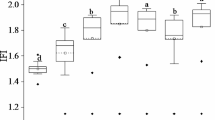Abstract
Yield responses of rice (Oryza sativa L. cv JD1187)to variable rates and combinations of fertilizer nitrogen (N) and phosphorus(P), to available soil N and P, and to cation exchange capacity (CEC) wereexamined in 41 field trials. The trial sites were located in the rice-growingregion of Hebei Province, Northern China, covering a diversity of soilfertilitylevels. Relationships between crop yields, fertilizer rates and soil nutrientsupply were established using an orthogonal polynomial model. The optimumeconomic fertilizer rates at different levels of soil N and P supply wereestimated by using fertilizer-yield response functions and soil properties foraparticular site. A difference in trend coefficients, reflecting yield responseto fertilizer, was observed, which was mainly dependent on variance of soilfertility across 41 experimental sites under the relatively consistent climateand farming practice. The results of correlation analysis showed that there wasa positive correlation between trend coefficient T0 and yieldwithoutfertilizer (Y0) (r = 0.80**). Trend coefficientT1, the major effect of N fertilizer on yield, showed negativerelationships with the quadratic transformation of alkali-hydrolysable N(Ns) and CEC (r = −0.60**). Trend coefficientT2, the major effect of P fertilizer on yield, had negativerelationships with the logarithmically transformed data of soilNaHCO3-extractable P (Ps) (r = −0.57**).Trend coefficients T3, T4 and T5, representinglinear interaction of N and P, and quadratic trend of N and P, respectively,showed no significant correlation with soil fertility variables. Yieldresponsesto N and P fertilizers, optimum economic fertilizer rates and gross profit fromfertilization decreased with increase in available soil N and P, and CEC. Themodel was validated in 19 field trials. The results suggest that the modeldeveloped in this study can reasonably predict optimum economic fertilizerratesthrough routine soil tests in the rice production region. The model can also beextrapolated to other regions and include other variable factors, provided thatnew relationships between yield response to fertilizer and site variables areestablished and incorporated into the model.
Similar content being viewed by others
References
Black C.A. 1965. Methods of Soil Analysis. Part 2. Chemical and Microbiological Properties. American Society of Agronomy, Madison, Wisconsin.
Colwell J.D. 1994. Estimating Fertilizer Requirements: A Quantitafertilizers tive Approach. CAB International, Wallingford, UK, 262 pp.
Colwell J.D. and Morton R. 1984. Development and evaluation of fertilizergeneral or transfer models of relationships between wheat yields and fertilizer rates in southern Australia. Austr. J. Soil Res. 22: 191–205.
Foth H.D. and Ellis B.G. 1996. Soil Fertility. Lewis Publishers, New York, 290 pp.
Li R.G. 1987. Fertilizer-Yield Response Functions. China Agricultural Press, Beijing, China, 180 pp.
Li R.G., Fan J.Z., Wang K.W. and Shen J. 1991. The development of fertilization models for rice. Present and Future of Soil Sciences in China. Science and Technology Press, Jiangsu, Soil Science Society of China, pp. 118–121.
Shen J. and Li R. 1999. Development of large-area economic fertilization models for rice by orthogonal trend analysis. China Plant Nutr. Fertil. Sci. 5: 258–262.
Shi R. 1986. Soil and Agricultural Chemistry Analysis. China Agricultural Press, Beijing, China, 388 pp.
Westerman R.L. 1990. Soil Testing and Plant Analysis. 3rd edn. American Society of Agronomy and Soil Science Society of America, Madison, Wisconsin.
Zellner A. 1962. An efficient method of estimating seemingly unrelated regressions and test for aggregation bias. J. Am. Stat. Assoc. 57: 348–368.
Author information
Authors and Affiliations
Rights and permissions
About this article
Cite this article
Zhang, F., Shen, J., Li, R. et al. Orthogonal polynomial models to describe yield response of rice to nitrogen and phosphorus at different levels of soil fertility. Nutrient Cycling in Agroecosystems 65, 243–251 (2003). https://doi.org/10.1023/A:1022644520090
Issue Date:
DOI: https://doi.org/10.1023/A:1022644520090




